three-particle harmonic decomposition
Title: Harmonic decomposition of three-particle azimuthal correlations at RHIC
PA's: Paul Sorensen, Jim Thomas, Prithwish Tribedy, and Ron Longacre
Target Journal: PRC (with interest in a possible short PRL focusing on model comparisons)
Preliminary Drafts:
Short paper (target journal : PLB) :
Long paper (target journal : PRC) :
Latest version : https://drupal.star.bnl.gov/STAR/system/files/3p_prc_08.pdf
Responses to institution comments on the Short paper: https://drupal.star.bnl.gov/STAR/system/files/shortpaper_comments.pdf
Responses to institution comments on the Long paper: https://drupal.star.bnl.gov/STAR/system/files/LongPaperResponses.pdf
Analysis Note: https://drupal.star.bnl.gov/STAR/system/files/BES_3P_AnalysisNote_3.pdf
Resubmission Edit :
https://drupal.star.bnl.gov/STAR/system/files/difference_sub_resub.pdf
Response to Referee :
https://drupal.star.bnl.gov/STAR/system/files/response_final.pdf
Data points : Short Paper (click here) Long Paper (click here)
Abstract:
We present STAR measurements of three-particle correlations for various harmonics in Au+Au collisions at energies ranging from $\sqrt{s_{NN}}=7.7$ to 200 GeV. The quantity $\langle\cos(m\phi_1+n\phi_2-(m+n)\phi_3)\rangle$ is evaluated as a function of collision centrality, $\sqrt{s_{NN}}$, transverse momentum $p_T$, pseudo-rapidity difference $\Delta\eta$, and harmonics (m and n). These data provide detailed information on global event properties like correlations between event planes of different harmonics and are particularly sensitive to the expansion dynamics of the matter produced in the collisions as well as transport properties. We compare our data to a hydrodynamic model that includes viscosity and non-linear couplings between various harmonics and find good agreement between the model and {\cabc} but poor agreement for other combinations of $m$ and $n$. Data also reveal interesting trends related to two-particle correlation functions relative to the second-order event-plane. These measurements provide ways to constrain models of heavy-ion collisions over a wide range of collision energies.
Conclusions:
We presented measurements of the $\Delta\eta$, $p_T$, centrality and energy dependence of three-particle azimuthal correlations {\cijk} for a variety of combinations of $m$ and $n$. We find a strong dependence of {\caab} on $|\eta_1-\eta_2|$, {\c123} on $|\eta_1-\eta_3|$, and {\cbbd} on $|\eta_{1,2}-\eta_3|$. The integrated correlations with $m=1$ are generally negative or consistent with zero except for {\cabc} which, at 200 GeV, is positive for most centralities while it is negative for all centralities at all of the lower energies. Non-zero values for {\c123} imply correlations between the second and third harmonic event plane that are predicted from models of the initial overlap geometry. At 200 GeV, a hydrodynamic model including viscosity and non-linear coupling between harmonics agrees with the centrality dependence of {\c123}. The model, however, seriously under-predicts the correlations for other combinations of $m$ and $n$. The $p_T$ dependence of the correlations exhibits trends suggesting significant differences between the correlations in peripheral collisions and more central collisions as well as differences for $p_T>5$ GeV/c and $p_T<5$ GeV/c. The quantity {\c123} as a function of $p_{T,1}$ changes sign as many as three times. While {\c112} is negative for higher energies, it becomes positive or consistent with zero at 7.7 GeV. The value of {\c224} decreases as energy is decreased from 200 GeV to 19.6 GeV and then remains flat below 19.6 GeV. By examining the energy dependence of {\c112}, {\c123}, {\c224}, and {\c235} we are able to infer that at 200 GeV, there is a preference for particle pairs to be emitted with angles relative to the reaction plane of either $\phi_1\approx\pi/3$ and $\phi_2\approx2\pi/3$ or $\phi_1\approx-\pi/3$ and $\phi_2\approx-2\pi/3$. At 62.4 GeV and below, the preference is for back-to-back pairs ($\phi_1\approx0$ and $\phi_2\approx\pi$) aligned with the reaction plane. These data will be useful for constraining hydrodynamic models while measurements of the charge dependence of the correlations presented here should provide valuable insights into whether or not the charge separation observed in heavy ion collisions is related to the chiral magnetic effect.
Motivations:
There are three general motivations to this analysis: 1) understand the initial overlap geometry, 2) constrain models, and 3) develop tools to better understand two-particle correlations relative to the reaction plane and possible signatures for CME.
Motivation 1:
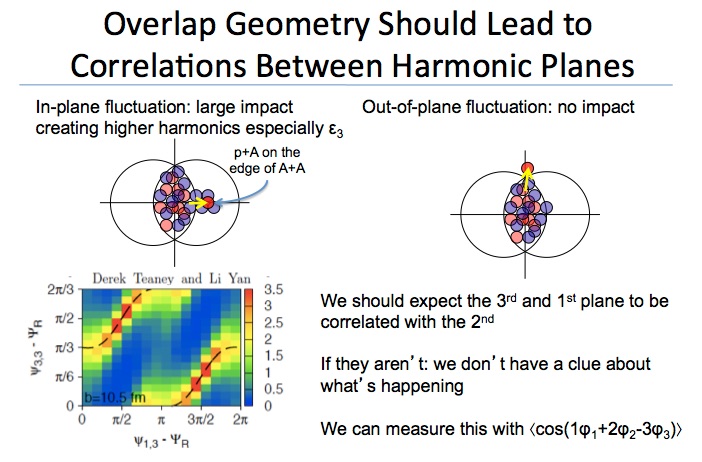
Motivation 2:

Motivation 3:

![]()
![]()
Figures:
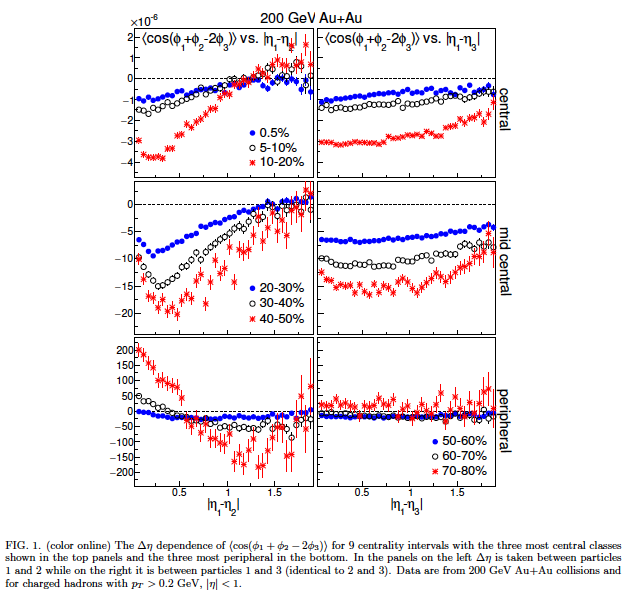
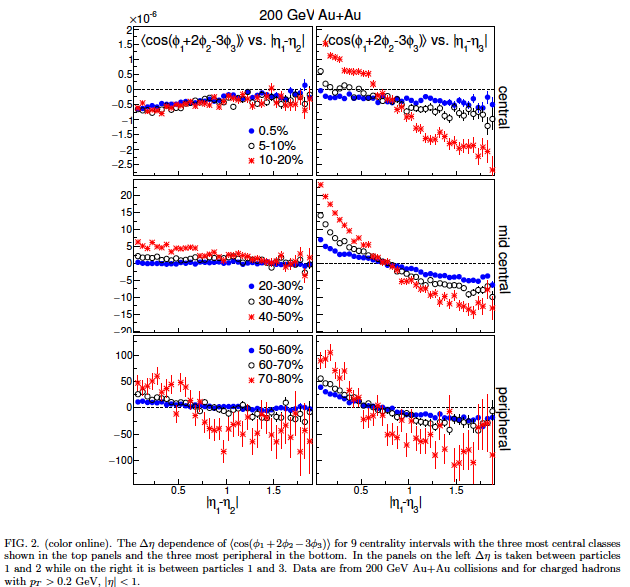




![]()
![]()
![]()
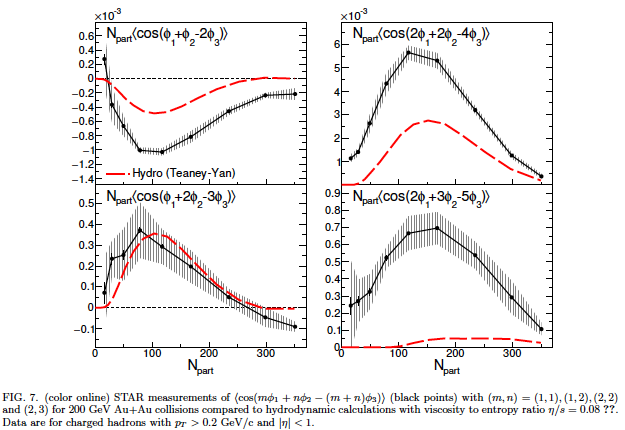
![]()
![]()
![]()


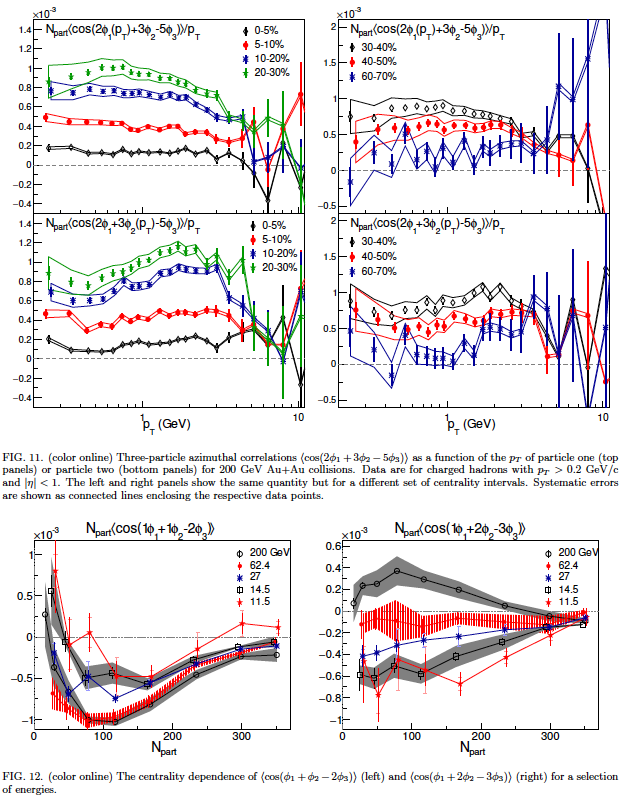
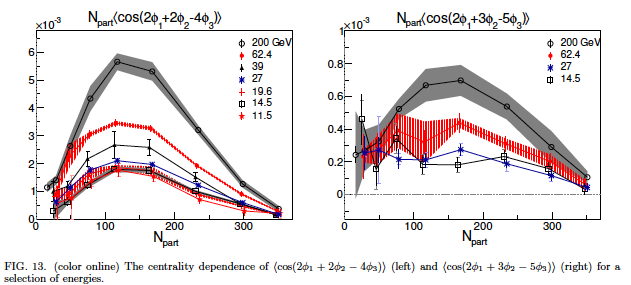

Supporting Material:
https://drupal.star.bnl.gov/STAR/system/files/sorensen_bulkcorr_01_29_14.pdf
https://drupal.star.bnl.gov/STAR/system/files/sorensen_starcollab_sbu.pdf
![]()
